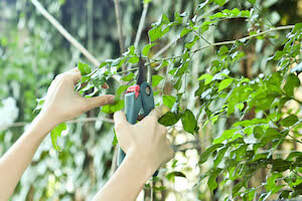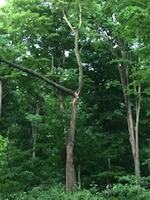 There are many good reasons to trim a tree, and it goes beyond making your yard look more appealing. One of the most obvious reasons to trim a tree is when it begins to envelop electrical lines or hang over your property. It is also time to trim unwanted limbs if they obstruct your view or your neighbor's. Whatever the reason may be, a tree could use some trimming and maintenance once a year for it to thrive vigorously. Failure to give importance to regular trimming means your tree is more vulnerable to damage and disease. It could also lead to your tree to look unpleasant and untidy. Untrimmed trees also tend to grow their branches in awry directions that could lead to its removal in the long run. Before you start trimming your tree, make sure you know the basic principles involved for a better result.
Trimming Seasons The right season for trimming depends on different factors and requires unique rules based on the species of the tree. You will not harm the tree if you do light pruning or removal of dead or damaged limbs, no matter what the season is. In fact, you may be doing it a favor because it can prevent further injury to the tree. It is important to recognize the differences of each species, so you can make sure you are trimming the tree at the most beneficial time. Most tree care experts suggest pruning trees in their dormant season. Doing this would result in healthier and more vigorous growth come spring. For best results, wait until the coldest part of winter has passed. You can trim between the last part of winter and early spring. Keep in mind that shade trees such as willow, oaks, and sycamore get the best of pruning if done during fall and winter. Further, flower-yielding trees such as cherry and magnolias are best pruned in the spring. Trimming Techniques You should take into account the height of the tree when trimming. Trees with compact crowns need to be trimmed. The crown of a tree comprises almost 2/3 of all its branches, that is why it is imperative to trim it if there are too many limbs and branches in this part. Always cut the branches just above a budding limb. If you cut the branch too short, it can affect the growth of the tree and even cause its death later on. Further, make it a point to cut at the right angle. Keep in mind that whatever the angle you cut the branch will affect the direction the limb will spring. A simple technique is to start with the big branches. This will give you room by eliminating branches that may be blocking your way to the smaller branches. Don't get carried away though when trimming, and protect the trunk throughout the process. Avoid making unnecessary cuts because it can cause serious damage to the tree's health. Accounting for Tree Age No matter the age of your tree, it would benefit from trimming. It is especially suggested for younger trees to be pruned early because it serves as training for better structure and growth in the years to come. Trees that are trimmed in their early years tend to have a better shape as they grow. Trees in their middle-ages are particularly in need of trimming, so make sure to have them pruned regularly. Older trees that have been annually pruned need less trimming as they mature. You only have to get rid of dead limbs and branches, and they're good to go. Equipment A successful trimming process also depends on the right tools used. Some of the most essential tools for this job are loppers, pruning saw, ladder, and pole pruners. Loppers are useful when you need to reach high limbs and branches because of its long handle. Pruning saw will come in handy when you need to cut off thicker branches. Pole pruners are helpful when loppers can't do the task. It can do the job more precisely thanks to its pulley system and saw head. You can place the tool at your desired position and pull the handle so it can begin cutting the branch you wish to eliminate. If you are still unable to reach the desired branch or limb, it's time to use a ladder. Make sure to climb up and down the ladder carefully for your safety. Once you're done using these tools, store them in a dry area to protect them from rust. Step-By-Step Guide Step 1: Look at the tree and imagine what you want to see when trimming is done. See if your tree is leaning, too crowded at the crown, or growing at a dangerous site like your house or an electrical line. Step 2: Use proper pruning tools like pruning saw and loppers to cut dead and damaged branches. Also, make sure to wear safety gears such as goggles to keep debris from getting in your eyes and blurring your vision. Step 3: Know which branches to prune. Don't begin until you're sure of the steps to take. If a limb is no longer serving the tree, it is safe to let it go. You should also practice pruning at the right angle. Step 4: After pruning, clear the area of debris and gather the limbs and branches to make sure they don't scatter during a storm. You can keep the woods to use for firewood or contact a local company to handle the job. For larger trees always hire a professional tree service.  If you have lush landscape on your property, you may find yourself wondering about tree health following a storm. We understand your dilemma because a strong storm can cause damage even to the healthiest tree out there. Trees that is no longer healthy and has structural issues are not only dangerous on your property but can also pose a threat to your life. Once you notice any signs of an unhealthy tree, do not delay to call a certified arborist to do an inspection and assess if the tree needs to be removed. When to Remove a Tree Removing a tree is a tough decision to make, especially if the tree has been in your yard for decades. However, if they are no longer safe to be around, there is no smarter choice but to remove them. Here are some signs to look for when deciding to remove a tree.
If you aren't confident with your diagnosis, it is best to let the Grace Tree Service do it because we will be able to tell what to do with your tree. |
AuthorGrace Tree Service Archives
February 2024
Categories
All
|
|
|

 RSS Feed
RSS Feed